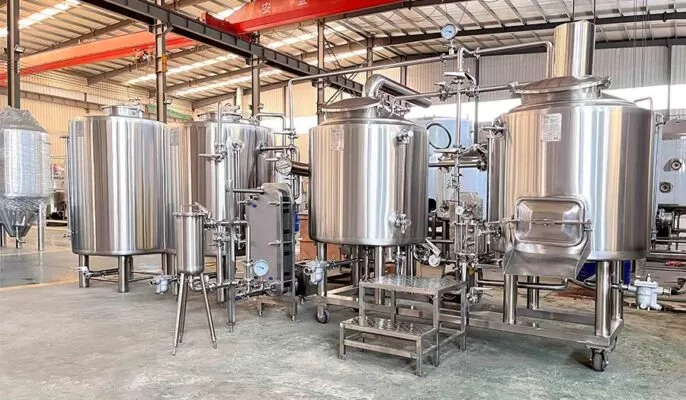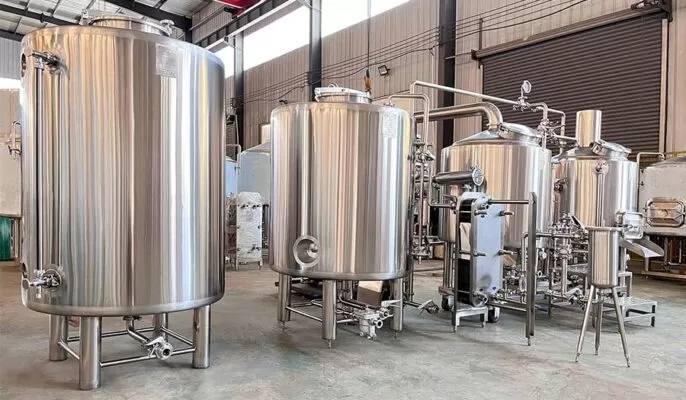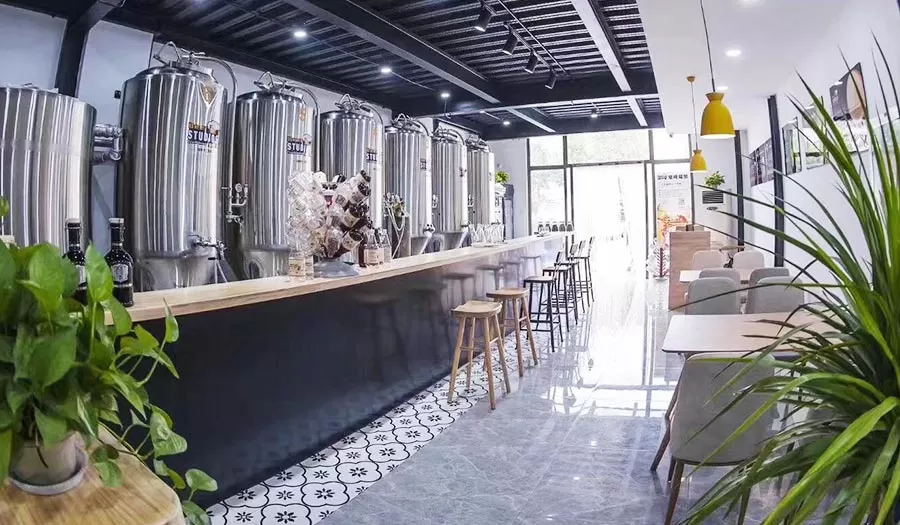Electric brewing involves using electricity to heat and control temperature throughout the brewing process. This is achieved through the use of an electric brewing system that includes a heating element, temperature controller and various accessories. With electric brewing, you have precise temperature control, allowing you to brew a variety of styles of beer with consistency.
Electric Brewing Equipment Overview
Heat source and temperature control
The brewing process requires heating liquid to cook the grains. It is then boiled for pasteurization and hops added. Let’s be honest, beer can be brewed in a kitchen pot on the stove. But, to brew delicious beer, temperature control is important.
Electric brewing systems also include a temperature controller. This device allows you to set and maintain the desired temperature throughout the brewing process. Some temperature controllers have built-in timers, which are helpful for timing different stages of the brewing process, such as mashing and boiling. The temperature controller is connected to the heating element and uses a sensor to watch the temperature of the liquid.

Brewing kettle
Most modern home brewing systems use a single kettle. The most important feature of a kettle is its size. To brew a 5-gallon batch, the kettle should be at least 10.5 gallons. Other important features include the number and type of ports in the kettle.
Pump
A good pump is important for brewing beer, you don’t want to see your pump get clogged during the brewing process. The most important thing for a pump is durability. Some pumps also work faster than others, but the volume of liquid in the brewing process is small enough that speed isn’t a big issue.
Types of Electric Brewing Systems
| TYPE | DESCRIPTION | PRICE RANGE |
| All-In-One Units | Fully automated brewing appliance with built-in boiler, pumps and controls | $800 – $2000 |
| Modular Systems | Customizable setup where kettles, heaters and pumps are separate | $1000 – $5000 |
Advantages of Electric Brewing
Electric brewing offers homebrewers a convenient and efficient way to brew beer. With precise temperature control, safety features, and the ability to try different techniques, electric brewing systems are becoming popular among brewing enthusiasts. Whether you’re a beginner or an experienced brewer, electric brewing can take your beer brewing to the next level.
Efficient
Electric brewing systems are very efficient, with almost no heat lost during the brewing process. This means you’ll waste less energy and save money in the long run. Unlike gas-powered brewing systems, where heat can escape through the burner or kettle, electric brewing systems are designed to keep heat, resulting in more efficient heating and less energy consumption.
High security
Traditional gas brewing systems present the risk of propane leaks or carbon monoxide poisoning. With electric brewing, there is no open flame or combustion, making it a safer option for home brewers. You can brew indoors without worrying about drafts or fire risks.
Precise temperature control
It’s crucial to brew certain beers that need specific temperature ranges for mashing and fermentation. With electric brewing, you can set and maintain your desired temperature, ensuring the consistency and quality of your beer.
Choosing the right electric brewing system
Choosing the right system is crucial. There are a variety of options to choose from, including pre-built electric brewing systems and DIY setups. Key factors to consider when selecting a system are batch size, power requirements and control capabilities. It is also important to ensure that the system is safe and reliable. Do your research and read reviews to find the best electric brewing system that fits your needs and budget.
A popular option for electric brewing systems is the all-in-one brewing system. These systems are designed to handle the entire brewing process from mashing to boiling and cooling. They often come with built-in temperature controls and timers, making it easier to maintain precise temperatures and follow recipes . An all-in-one system is a great option for beginners or those who prefer a more streamlined brewing process.
Brewing process using an electric system
- Mashing: Mixing the grains with hot water and maintaining it at a temperature of 150-160°F converts the starches into fermentable sugars. Electric heating elements and pumps recirculate the wort.
- Filtration: Use a filtration system or spray arms to separate the wort (sugary liquid) from the grain material.
- Boil: An electric heating element boils the wort for 60-90 minutes, adding hops at various times. Preset recipes provide timing guidance.
- Fermentation: The cooled wort is transferred to a fermenter where yeast converts the sugars into alcohol over the days/weeks before bottling.
Precautions after brewing
First the wort needs to be transferred to the fermenter and yeast added to start fermentation. This is where the magic happens, as the yeast consumes the sugar in the wort and converts it into alcohol and carbon dioxide. It is important to check the fermentation process and ensure the beer is fermenting at the desired temperature by taking regular gravity readings.
Once fermentation is complete, the beer is ready for bottling or kegging. This step involves transferring the beer from the fermenter into individual bottles or kegs. It is important to handle the beer to avoid disturbing any sediment that may have settled during the fermentation process.
Whether you choose bottling conditions or forced carbonation, the process requires patience. Carbonation adds a pleasant fizz and bubbles to your beer, enhancing its drinking experience.
Safety measures for electric brewing
Electrical Safety Tip
Working with electricity requires extreme caution to ensure your safety. When setting up an electric brewing system, be sure to follow the manufacturer’s instructions and consult a qualified electrician if needed. Always use a ground fault circuit interrupter (GFCI) to protect yourself from electrical shock and cut the risk of an accident. Check your equipment for any signs of wear or damage and replace any faulty components .
Safe handling of brewing equipment
It is also important to operate brewing equipment to avoid injuries and accidents. When working with hot liquids, always use heat-resistant gloves and take care to prevent burns. When moving heavy pots or kegs, follow proper lifting techniques to avoid strain or injury. Make sure to store chemicals and cleaning agents in a safe place away from children and pets.

Comparing Electric and Stovetop Brewing Systems
| PARAMETER | ELECTRIC BREWING SYSTEMS | STOVETOP BREWING |
| Temperature Control | Precise, automated heating cycles | Manual control with propane or gas stove |
| Ease of Use | Preset recipes, automation | Requires monitoring and manual adjustments |
| Consistency | Each batch more standardized | Variability across batches |
| Convenience | Compact, all-in-one, quiet | More equipment, lifting, cleanup |
| Cost | $800 – $2000 typical | $200 – $800 for basic equipment |
Common electric brewing questions
Q: Is the electric brewing system easy to use for beginners?
A: The state-of-the-art electrical system provides intuitive controls, preset guidance and automation to streamline key parts of the brewing process. But, some familiarity can still help produce high-quality results.
Q: Can an electric brewing system produce the same quality beer as a professional brewery?
A: Advanced electric homebrewery systems can replicate critical temperature stages, ingredient additions and filtration to meet commercial standards. The key factors for quality are the recipe, ingredients, fermentation and bottling process.
Q: Do I need to cool the wort with an electric brewing system?
A: Some high-end models offer automatic cooling via a cold plate or cooler. Otherwise, the wort needs to be cooled in a water tank ice bath before being transferred to the fermenter. This prevents odors from developing.
Q: How many batches can an electric brewing system produce?
A: A typical homebrew system can produce 5-10 gallon batches. Larger units are also available in 15-20 gallon batch sizes. Professional nanoelectric brewers can produce 1-gallon batches.




